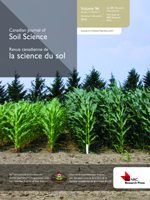Drury, C. F., Reynolds, W. D., Tan, C. S., McLaughlin, N. B., Yang, X. M., Calder, W., Oloya, T. O. and Yang, J. Y. 2014. Impacts of 49-51 years of years of fertilization and crop rotation on growing season nitrous oxide emissions, nitrogen uptake and corn yields. Can. J. Soil Sci. 94: 421-433. A field study was established in 1959 to evaluate the effects of fertilization and crop rotation on crop yields, soil and environmental quality on a Brookston clay loam. There were two fertilizer treatments (fertilized and not-fertilized) and six cropping treatments including continuous corn (CC), continuous Kentucky bluegrass sod and a 4-yr rotation of corn-oat-alfalfa-alfalfa with each phase present each year. We measured N2O emissions, inorganic N and plant N uptake over three growing seasons (2007-2009) in the corn phase. Nitrous oxide emissions varied over the 3 yr as a result of the seasonal variation in precipitation quantity, intensity and timing and differences in crop growth and N uptake. Fertilized CC lost, on average, 7.36 kg N ha-1 by N2O emissions, whereas the not-fertilized CC lost only 0.51 kg N ha-1. Fertilized rotation corn (RC) lost 6.46 kg N ha-1, which was 12% lower than fertilized CC. The not-fertilized RC, on the other hand, emitted about half as much N2O (2.95 kg N ha-1) as the fertilized RC. Fertilized RC had corn grain yields that averaged 10.0 t ha-1 over the 3 yr followed by fertilized CC at 5.48 t ha-1. Not-fertilized RC corn had yields that were 61% lower (3.93 t ha-1) than fertilized RC, whereas the not-fertilized CC had yields that were 75% lower (1.39 t ha-1) than fertilized CC. Nitrous oxide emissions were found to be dramatically affected by long-term management practices and crop rotation had lower emissions in the corn phase of the rotation even though the N input from fertilizer addition and legume N fixation was greater. These N2O emission and yield results were due to both factors that are traditionally used to describe these processes as well as long-term soil quality factors, which were created by the long-term management (i.e., soil organic carbon, soil physical parameters such as bulk density, and porosity, soil fauna and micro-flora) and that influenced crop growth, N uptake and soil water contents.
How to translate text using browser tools
6 March 2014
Impacts of 49–51 years of fertilization and crop rotation on growing season nitrous oxide emissions, nitrogen uptake and corn yields
C. F. Drury,
W. D. Reynolds,
C. S. Tan,
N. B. McLaughlin,
X. M. Yang,
W. Calder,
T. O. Oloya,
J. Y. Yang
ACCESS THE FULL ARTICLE
It is not available for individual sale.
This article is only available to subscribers.
It is not available for individual sale.
It is not available for individual sale.

Canadian Journal of Soil Science
Vol. 94 • No. 3
August 2014
Vol. 94 • No. 3
August 2014
conduite de cultures
crop management
Émissions de N2O
fertilisation azotée
N2O emissions
Nitrogen fertilization




